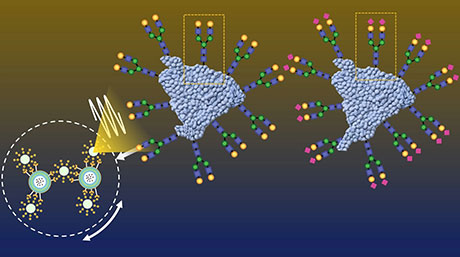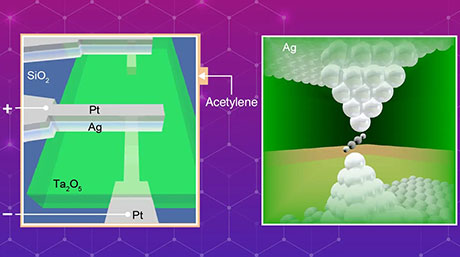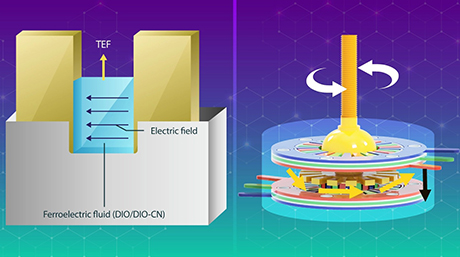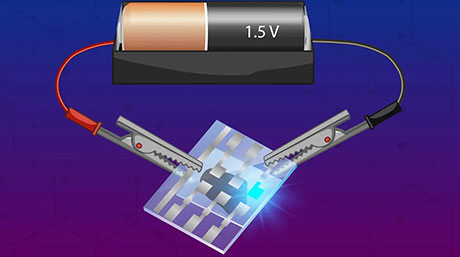Materials Science and Engineering News
ASUNARO Grant established, 5 researchers including Assist. Prof. Chiu Wan-Ting awarded in first call
Tokyo Institute of Technology, with a donation from Professor Emeritus Koichi Asano, established the ASUNARO Grant to support researchers under 45 years of age engaged in basic research. In the first call of the grant, five researchers were selected, and a ceremony to present the researchers with their award notices was held online on July 6.

(From top left) Executive Vice President for Research Watanabe, President Masu, Professor Emeritus Asano and five grant recipients(Assistant Professor Chiu Wan-Ting(lower left))
Background of ASUNARO Grant
The grant was established in FY2020, in response to Professor Emeritus Asano's wish to donate a portion of the proceeds from his research, saying, "I am grateful to society for the many years of support that allowed my work in basic research to flourish. In return, I would like to use the funds to support basic research by future generations."
Professor Emeritus Koichi Asano has studied the precise separation of multicomponent systems and developed a theoretical system for multicomponent distillation that can be applied to a wide range of temperatures, including cryogenic temperatures. He also succeeded in developing a plant for the production of "Water-18O", which is a raw material for diagnostic reagents used in PET, a method widely used in cancer screening.
First award ceremony held and five selected researchers presented their research
This is the first time the Institute has provided the grant, for which 33 researchers applied and 5 were selected as recipients.
-
Shigeru KAKU
Assistant Professor / Department of Physics, School of Science -
Hirokazu KUWAHARA
Assistant Professor / Department of Life Science and Technology, School of Life Science and Technology -
Tetsuya YAMADA
Assistant Professor / Laboratory for Future Interdisciplinary Research of Science and Technology, Institute of Innovative Research -
Chiu Wan-Ting
Assistant Professor / Laboratory for Materials and Structures and Laboratory for Future Interdisciplinary Research of Science and Technology, Institute of Innovative Research -
Ryosuke TAKEHARA
Assistant Professor / Laboratory for Chemistry and Life Science, Institute of Innovative Research
At the ceremony to present the recipients with their award notices, President Kazuya Masu stated in a speech that he was looking forward to seeing the development of their research. Professor Emeritus Asano also addressed the recipients expressing high hopes for the steady development of their research activities and ultimately a fruitful outcome by the end of their long-term efforts. Following the speech, recipients presented their research and then had a deep and active discussion with Professor Emeritus Asano, President Masu, Osamu Watanabe, Executive Vice President for Research, and Kaoru Kuwata, Vice President for Research Development.
Overview of the ASUNARO Grant
Objective
The Fund is designed to provide financial support to researchers engaged in fundamental science and engineering research, including steady research in mature engineering fields, engineering research that explores new possibilities based on a long-term perspective without being influenced by trends, and original engineering research for which it is difficult to acquire funding.
Eligibility
Associate Professor, Associate Professor(Lecturer), or Assistant Professor who is employed by Tokyo Tech and under 45 years of age as of April 1, 2021. Specially Appointed Faculty is excluded.
Research support period
As a general rule, the support period is 1 year from the day the research support begins. However, depending on the research plan, it is possible to apply for a 2-year period.
Amount of support
1,000,000 yen per research proposal.
FY2021 Recipients of ASUNARO Grant
Chiu Wan-Ting
Assistant Professor / Laboratory for Materials and Structures and Laboratory for Future Interdisciplinary Research of Science and Technology, Institute of Innovative Research
Research Topic
Enhancement of the deformation behavior of the defect–less NiMnGa particle/polymer composite by the grain separators
Research Outline
【Development of single crystal ferromagnetic shape memory alloy with ultra–low defect】
Shape deformation and internal degree of freedom of the ferromagnetic shape memory alloy (FSMA) are manipulatable via magnetic field. Hence, FSMA is considered as a potential material for the high–speed actuators in robots and magnetic cooling applications. NiMnGa alloy is a promising FSMA; however, its high brittleness impedes the practicability. Therefore, in this study, the separators (i.e. S or Bi) were introduced into the polycrystalline NiMnGa alloy intentionally to separate the grains and make the alloy even brittle. The polycrystalline NiMnGa is thereafter mechanically crushed into single crystal powders at elevated temperature. The conventional difficulties such as high defect concentration and complicated procedures for single crystal preparation could be solved by the facile mechanical crushing. The NiMnGa single crystal powders are then utilized for the fabrications of the composites for realizing the high–speed actuators for robots and magnetic cooling applications.
- Researcher Profile | Tokyo Tech STAR Search - Wan Ting Chiu
- Hosoda and Tahara Laboratory
- Laboratory for Materials and Structures, Institute of Innovative Research
- Laboratory for Future Interdisciplinary Research of Science and Technology (FIRST)
- Institute of Innovative Research (IIR)
- Materials Science and Engineering Graduate Major|Education|Department of Materials Science and Engineering, School of Materials and Chemical Technology
Shigeru KAKU
Assistant Professor / Department of Physics, School of Science
Research Topic
Ideal interface control for Graphene/III-V compound semiconductor hybrid materials
Research Outline
Today's comfortable society and our lives are supported by functional materials that can control electrons and light. The 2D materials discovered in recent years have novel properties not found in conventional 3D materials, so their applications as functional materials are being studied worldwide. One of them is to combine the functionality of 3D and 2D materials. Ideally, the interface between the two should be controlled to be completely clean, but such a transfer method for 2D materials has not yet been established. In this study, I develop an ideal transfer technique using an ultra-high vacuum environment.
Hirokazu KUWAHARA
Assistant Professor / Department of Life Science and Technology, School of Life Science and Technology
Research Topic
Localization analysis with electron microscopy-in situ hybridization (EM-ISH) and elucidation of a symbiotic evolution using genome analysis of symbiotic Alphaproteobacteria in the termite gut
Research Outline
Symbiosis is a driving force for biological evolution, as the origin of mitochondria is an alphaproteobacterium that established a symbiotic relationship with a eukaryotic ancestor. Symbiosis between protists (unicellular eukaryotes) and alphaproteobacteria is also found in the termite gut, and the study may capture a phenomenon resembling the early process in that the eukaryotic ancestor established the symbiotic relationship with the mitochondrial ancestor. The purpose of this study is to elucidate the symbiotic ultrastructure of the alphaproteobacteria with protists in the termite gut by electron microscopy with in situ hybridization (EM-ISH), and the symbiotic evolutional mechanism by a genome analysis of the alphaproteobacteria. The EM-ISH analysis reveals an ultrastructure of the symbiotic alphaproteobacteria within the host protist by electron microscopy using a specific probe bound with a colloidal gold. Furthermore, the alphaproteobacteria cells are recovered by micromanipulation, applied to whole genome amplification, and the genome analysis of the alphaproteobacteria can clarify the symbiotic evolutional mechanism.
Tetsuya YAMADA
Assistant Professor / Laboratory for Future Interdisciplinary Research of Science and Technology, Institute of Innovative Research
Research Topic
Fast Ion Transport Induced in Two Dimensional Nanosheet
Research Outline
Ionic conductors, solid with ion conductivity, are essential materials used in various applications such as batteries and chemical sensors. Higher ion conductivities are reported when the size of ionic conductors is small at the nanometer level (Nanoionics phenomenon). The spatial conditions and mechanism of the fast ion conduction shown in the nanoscale remain unexplained.
In this study, we applied single-crystal nanosheets of zirconia (ZrO2), which is an oxygen ion conductor, to clarify the mechanism of fast ion conduction. The advantages of using nanosheets with a two-dimensional structure are that nanosheets are easily deposited on a substrate, and their conductivity is measure by nanoprobes. In addition, the relationship between nano-space and ionic conduction can be explored by changing the size of the nanosheets.
Ryosuke TAKEHARA
Assistant Professor / Laboratory for Chemistry and Life Science, Institute of Innovative Research
Research Topic
Topological structures generated by a molecular rotor assembly and their responses to external fields
Research Outline
Recently, the physical properties associating with topology have been enthusiastically studied in the field of condensed matter physics, the concept of which was first introduced as a vortex forming in two-dimensional (2D) systems. Although the vortices have been discovered in superconducting and superfluid thin films, an electrical vortex structure consisting of electric dipole moments has never been found so far. This is because that it has been difficult to create a material that would realize such a structure. Recently, however, a molecular rotor in which the electric dipole moment upon a scaffold tripodal molecule rotates has been developed. The tripodal molecules are arranged in a nested 2D arrangement to form a 2D molecular rotor system, which is exactly the same structure where the vortex was first introduced. In this study, I'll make an attempt on a first observation of the 2D electrical vortex structure expected to emerge in the molecular rotor assembly. Additionally, since the vortex is an electrical one, direct control of the vortex by an electric field is also expected, and these realizations will provide new insights into the field of topology.





